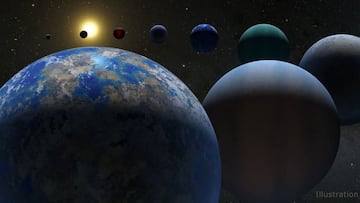NASA's exoplanet count tops 5,000: is there life out there?
Nearly 30 years ago we identified the first planet orbiting a star that wasn't our Sun. Now, with the latest space exploration tools, we see so much more.


Way back in 1995 those folk with the rather powerful telescopes first discovered a planet orbiting a star outside of our very own solar system. Now, almost 30 years on, the number of confirmed ‘exoplanets’ has just passed the 5,000 mark. This is exciting.
Exoplanets: from 51 Pegasi b to 5,000 more
The count of these is kept by NASA's Exoplanet Archive, which records discoveries of these bodies that appear in peer-reviewed scientific papers and are confirmed by multiple detection methods and analytical techniques. The ‘planetary odometer’, as it’s called, surpassed 5,000 this week with its most recent batch of 65 exoplanets added to NASA's archive.
You may also enjoy:
- How are Elon Musk's 'Starlink' satellites connecting Ukrainians?
- NASA release stark image of Ukraine from space
- What would NASA do if an asteroid were to hit Earth? When is the next asteroid coming?
- How astronaut twins smuggled a gorilla suit aboard the ISS
The first planet detected on a Sun-like star, in 1995, was 51 Pegasi b, located 50 light years from Earth. It is a gas giant with half the mass of Jupiter and in an extremely close orbit to its star. Unlike our 365 days, a year there lasts just four. This planet discovery was made by Swiss scientists Michel Mayor and Didier Queloz, who were awarded the 2019 Nobel Prize in Physics for their contribution to the understanding of the evolution of the universe and Earth's place in the cosmos.
NASA finds Earth-like planets in other systems
The more than 5,000 planets found so far include small rocky worlds like Earth, gas giants many times larger than Jupiter and what are known as’ hot Jupiters’ in blisteringly close orbits around their stars, NASA explained.
There are also so-called ‘super-Earths’, which are possiblly rocky worlds larger than our own, and ‘mini-Neptunes’, as well as planets orbiting two stars at once. Then there are others that are circling collapsed remnants of dead stars.
"It's not just a number," according to the Archive's scientific director and NASA Exoplanet Science Institute researcher Jessie Christiansen, because "every one of them is a new world, a whole new planet" that we now get to explore further.
Of course we discovered this because one person was somehow inexplicably upside-down when the call started so we spent the first five minutes of the call collectively trouble-shooting until we were all rotating around like a bunch of goofs. https://t.co/6GFH0c61JU
— Dr. Jessie Christiansen (@aussiastronomer) March 22, 2022
Speaking with UK radio station LBC on Tuesday, Dr Aurora Kesseli research scientist at the California institute - you can follow her on Twitter - answered a raft of probing questions, including that never-ending human quest to know if life exists on other planets.
“I feel like the last 30 years our goal was just to detect the planets and we haven’t done a whole lot to figure out what the planets are made of, or what’s in their atmosphere,” says Kesseli, something she believes is now the focus for the next 30 years.
Big moment today for the exoplanet archive. So happy to be working on this science team with such amazing colleagues!! 🪐🎉 https://t.co/A0gbOEw8UW
— Aurora Kesseli (@aurora_kess) March 21, 2022
TRAPPIST-1 system is of particular interest to some, and the doctor gave a little insight into the seven planets orbiting its small star - around a tenth of the size of our Sun.
Related stories
“The habitable zone means that it is the right distance away from the star so that, if there was water on the planet’s surface then it would be liquid. On Earth we know that this is necessary for life.” She also strengthened the case that a simple hydrogen and oxygen based liquid like water is a realistic assumption about the creation of life.
Clearly there is so much more still to know. What is out there is still a mystery to some degree…but less of a mystery than it was yesterday.

